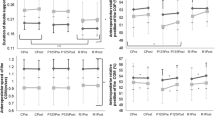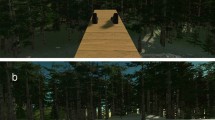Abstract
We tested the hypotheses that: (1) anxiety regarding the possibility of falling alters the attentional demands of gait; and (2) this alteration in the attentional requirements of gait occurs independently of gait pattern accommodations. Sixteen younger and 15 older adults participated in this study. Subjects walked at a self-determined velocity along a 7.2-m walkway under four conditions of postural threat; the walking conditions varied depending on the width constraints of the walkway (60 cm vs 15 cm) and the height of the walking surface (0 cm vs 60 cm). Attentional demands of locomotion in each condition of testing were assessed using the dual-task methodology, in which participants verbally responded to an auditory cue as quickly as possible while continuing to walk. Our findings revealed that: (1) participants were successful in verbally responding to the auditory cue without modifying their gait pattern; (2) reaction times increased for all subjects when walking in the condition of greatest postural threat; (3) the attentional demands for locomotion varied with the phase of the gait cycle for younger adults but not for older adults; (4) the phase-dependent effect for younger adults disappeared in the condition of greatest postural threat, while reaction time scores for older adults systematically increased; and (5) increases in reaction time persisted despite significant changes in gait kinematics. Our findings confirm that anxiety increases the attentional demands for locomotion and provide further explanation for age-dependent increases in the attentional demands of gait. Furthermore, our findings confirm that fall-related anxiety predicates an increase in the allocation of attention to locomotor control that is independent of gait pattern adjustments.







Similar content being viewed by others
References
Abernethy B, Hanna A, Plooy A (2002) The attentional demands of preferred and nonpreferred gait patterns. Gait Posture 15:256–265
Adkin AL, Frank JS, Carpenter MG, Peysar GW (2002) Fear of falling modifies anticipatory postural control. Exp Brain Res 143:160–170
Ashcroft KR, Guimaraes FS, Wang M, Deakin JF (1991) Evaluation of a psychophysiological model of classical fear conditioning in anxious patients. Psychopharmacology (Berl) 1(4):215–219
Broadhurst PL (1959) The interaction of task difficulty and motivation: the Yerkes-Dodson Law revisited. Acta Physiol (Amsterdam) 16:321–338
Brown LA, Frank JS (1997) Postural compensations to the potential consequences of instability: kinematics. Gait Posture 6:89–97
Brown LA, Shumway-Cook A, Woollacott MH (1999) Attentional demands and postural recovery: the effects of aging. J Gerontol A Biol Sci Med Sci 54:165–171
Brown LA, Gage WH, Polych MA, Sleik RJ, Winder TR (2002a) Central set influences on gait: age-dependent effects of postural threat. Exp Brain Res 145:286–296
Brown LA, Sleik RJ, Polych MA, Gage WH (2002b) Is the prioritization of postural control altered in conditions of postural threat in younger and older adults? J Gerontol A Biol Sci Med Sci 57:785–792
Dietrich S, Roaman MH (2001) Physiologic arousal and predictions of anxiety by people who stutter. J Fluency Disord 26:207–225
Downton JH, Andrews K (1990) Postural disturbance and psychological symptoms amongst elderly people living at home. Int J Geriatr Psychiatry 5:93–98
Eysenck MW (1992) Anxiety: The cognitive perspective. Erlbaum, London
Fearing FS (1925) Factors influencing static equilibrium: an experimental study of the effect of controlled and uncontrolled attention upon sway. J Comp Psychol 5:1–25
Hunter MC, Hoffman MA (2001) Postural control: visual and cognitive manipulations. Gait Posture 13:41–48
Kahneman D (1973) Attention and effort. Prentice-Hall, Englewood Cliffs, NJ
Kerr B, Condon SM, McDonald LA (1985) Cognitive spatial processing and the regulation of posture. J Exp Psychol Gen 5:617–622
Kurosawa K (1994) Effects of various walking speeds on probe RT during treadmill walking. Percept Mot Skills 78:771–776
Lachman ME, Howland J, Tennsteldt S, Jette A, Assmann S, Peterson EW (1998) Fear of falling and activity restriction: the survey of activities and fear of falling in the elderly (SAFE). J Gerontol B Psychol Sci Soc Sci 53:43–50
Lajoie Y, Teasdale N, Bard C, Fleury M (1993) Attentional demands for static and dynamic equilibrium. Exp Brain Res 97:139–144
Lajoie Y, Teasdale N, Bard C, Fleury M (1996a) Attentional demands for walking: age-related changes. In: Ferrandez AM, Teasdale N (eds) Changes in sensory motor behavior in aging. Elsevier, pp 235–256
Lajoie Y, Teasdale N, Bard C, Fleury M (1996b) Upright standing and gait: are there changes in attentional requirements related to normal aging? Exp Aging Res 22:185–198
Lajoie Y, Teasdale N, Cole JD, Burnett M, Bard C, Fleury M, Forget R, Paillard J, Lamarre Y (1996c) Gait of a deafferented subject without large myelinated sensory fibers below the neck. Am Acad Neurol 47:109–115
Li K, Lindenberger U, Freund AM, Baltes PB (2001) Walking while memorizing: age-related differences in compensatory behavior. Psychol Sci 12:230–237
Maki BE, McIlroy WE (1996) Influence of arousal and attention on the control of postural sway. J Vestib Res 6:53–59
Maki BE, Holliday PJ, Topper AK (1991) Fear of falling and postural performance in the elderly. J Gerontol A Biol Sci Med Sci 46:123–131
Marsh AP, Geel SE (2000) The effect of age on the attentional demands of postural control. Gait Posture 12:105–113
Maylor EA, Wing A (1996) Age differences in postural stability are increased by additional cognitive demands. J Gerontol B Psychol Sci Soc Sci 51:143–154
McAuley E, Mihalko SL, Rosengren K (1997) Self-efficacy and balance correlates of fear of falling in the elderly. J Aging Phys Act 5:329–340
McKenzie NC, Brown LA (2003) Obstacle negotiation: effects of postural threat. Gait Posture (in press)
Mickelborough J, Linden ML van der, Richards J, Ennos AR (2000) Validity and reliability of a kinematic protocol for determining foot contact events. Gait Posture 11:32–37
Murphy SL, Williams CS, Gill TM (2002) Characteristics associated with fear of falling and activity restriction in community-living older persons. J Am Ger Soc 20:216–20
Naveteur J, Roy J (1990) Electrodermal activity of low and high trait anxiety subjects during a frustrative video game. J Psychophys 4:221–7
Parfitt G, Hardy L, Pates J (1995) Somatic anxiety and physiological arousal: their effects upon a high anaerobic, low memory demand task. Int J Sport Psychol 26:196–213
Powell LE, Myers AM (1995) The activities-specific balance confidence (ABC) scale. J Gerontol A Biol Sci Med Sci 50:28–34
Prince F, Corriveau H, Hebert R, Winter D (1997) Gait in the elderly. Gait Posture 5:128–135
Redfern MS, Jennings JR, Martin C, Furman JM (2001) Attention influences sensory integration for postural control in older adults. Gait Posture 14:211–216
Redfern MS, Muller MLTM, Jennings JR, Furman JM (2002) Attentional dynamics in postural control during perturbations in young and older adults. J Gerontol B Psychol Sci Soc Sci 57:298–303
Shumway-Cook A, Woollacott M, Kerns KA, Baldwin M (1997) The effects of two types of cognitive tasks on postural stability in older adults with and without a history of falls. J Gerontol A Biol Sci Med Sci 52:232–240
Teasdale N, Simoneau M (2001) Attentional demands for postural control: the effects of aging and sensory reintegration. Gait Posture 14:203–210
Teasdale N, Bard C, LaRue J, Fleury M (1993) On the cognitive penetrability of postural control. Exp Aging Res 19:1–13
Wilken J, Smith BD, Tola K, Mann M (1999) Anxiety and arousal: tests of a new six-system model. Int J Psychophys 33:197–207
Williams JMG, Watts FN, MacLeod C, Matthews A (1988) Cognitive psychology and emotional disorders. Wiley, New York
Winter DA, Patla AE, Frank JS, Walt SE (1990) Biomechanical walking pattern changes in the fit and healthy elderly. Phys Ther 70:340–347
Woollacott M, Shumway-Cook A, Nashner L (1986) Aging and postural control: changes in sensory organization and muscular coordination. Int J Hum Dev 23:97
Yerkes RM, Dodson JD (1908) The relation of strength of stimulus to rapidity of habit-formation. J Comp Neurol Psychol 18:459–482
Acknowledgements
The authors gratefully acknowledge the contributions of: Dr. Toni Winder for the neurological screening of our elderly participants; Kendra Massie and Mitchell Champney for assistance on data collections; as well as Greg Tompkins and Frank Klassen for equipment construction and hardware technical assistance. This research is supported by grants from the MSI foundation (grant no. 739) and the Alberta Heritage Foundation for Medical Research to L. Brown and NSERC to W. Gage.
Author information
Authors and Affiliations
Corresponding author
Rights and permissions
About this article
Cite this article
Gage, W.H., Sleik, R.J., Polych, M.A. et al. The allocation of attention during locomotion is altered by anxiety. Exp Brain Res 150, 385–394 (2003). https://doi.org/10.1007/s00221-003-1468-7
Received:
Accepted:
Published:
Issue Date:
DOI: https://doi.org/10.1007/s00221-003-1468-7




